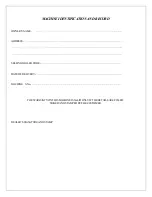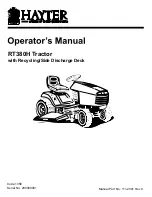
9
1.3 Preventing Farm Machine Hazards
The following article describes important general safety precautions for machinery such as the NT-204C/NT-254
tractor. It is reprinted here with permission from Professor Thomas L. Bean, Safety Leader and Professor,
Department of Food, Agricultural, and Biological Engineering, The Ohio State University Extension, The Ohio
State University.
AEX-593-91
Thomas L. Bean
Each year, 2,600 farm residents are killed and 230,000 disabled in farm-related injuries, many due to farm
machinery. Farm machinery uses mechanical power to do work. This creates a number of possible hazards for
both operators and bystanders. Even though manufacturers take many steps to make machinery safe, all hazards
cannot be removed. Some machine parts cannot be completely shielded and still do their job. For instance, a
totally enclosed cutting blade could not cut.
Many machinery-related accidents result from human error. The operator either forgot something, took a shortcut
or a risk, ignored a warning, wasn’t paying close attention, or failed to follow safety rules. In addition, guards
removed for maintenance often aren’t replaced.
There are many different kinds of farm machinery: mowers, tractors, shredders, harvesters, grinders, blowers,
augers, balers, etc. They all have similar characteristics and hazards. You can be cut, crushed, pulled in or struck
by an object thrown by these machines. They have cutting edges, gears, chains, revolving shafts, rotating blades,
pinch points and other hazards. You can also be injured if you fall while working on or near any of these
machines.
Accidents with farm machinery are often serious, even fatal. It is important to recognize and be alert for machine
hazards and to take precautions to avoid injury.
Shear and Cutting Points
Shear points (Fig. 1 below) are created when the edges of two objects are moved together closely enough to cut
a soft material, as with a pair of shears or an auger. Cutting points are created when a single object moves
forcefully or rapidly enough to cut, as with a rotary mower blade.
Figure 1
Both shear and cutting points are created on machinery designed to cut, such as harvesters, and on those that are
not designed to cut, such as augers. They are hazardous because of their cutting force and they often move so













































